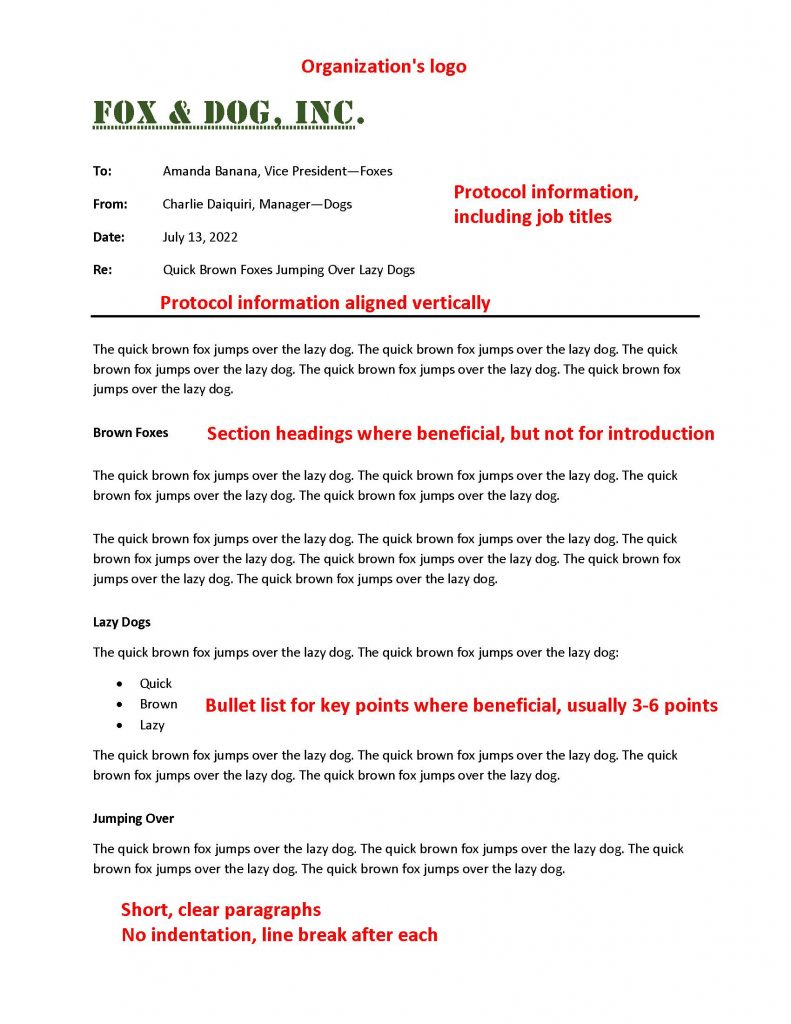Professional Correspondence
19 Professional Memos
Memoranda, or memos, are one of the most versatile document forms used in professional settings. Memos are “in-house” documents (generally sent within an organization) to pass along or request information, outline policies, present short reports, or propose ideas. A company or institution typically has its own in-house style or template that is used for documents such as letters and memos. If not, use the most standard format available, as demonstrated below.
Memo format
The example below shows the standard memo style used by most organizations, with red annotations pointing out various relevant features. The main formatted portions of a memo are the logo or letterhead (which is optional), the header block where the protocol information is located, and the body of the memo.

Header block
The header block appears at the top left side of your memo, directly underneath the organization’s logo. Sometimes the word “MEMO” or “MEMORANDUM” will appear between the logo and the header block, but the reader can see from the format that the document is a memo, so it is often omitted. This section contains detailed information on the recipient, sender, and purpose. It includes the following lines:
- TO: give the recipient’s full name and position or title within the organization.
- FROM: include the sender’s (your) full name and position or title.
- DATE: include the full date on which you sent the memo.
- SUBJECT or RE: write a brief phrase that concisely describes the main content of your memo.
Note how the header leads are vertically aligned, as is the content that follows the leads (as pictured above).
When a memo is being sent to an external audience, as in a different organization, include the name of the external organization next to the audience’s job title and your own organization next to your job title.
Place a horizontal line under your header block and place your message below.
Body text
The length of a memo can range from a few short sentences to a multi-page report that includes figures, tables, and appendices. Whatever the length, there is a straightforward organizational principle you should follow. Organize the content of your memo so that it answers the following questions for the reader:
- Introduction: What is this document? What is its purpose? Why was it written? Why is it being sent to the reader? These questions could all potentially be answered in two or three sentences. (Note: The heading “introduction” isn’t usually used in a memo because, well, what else would the first paragraph be? The heading is used in longer reports because the first section is not always the introduction.)
- Body paragraphs: What does the reader need to know? Give enough information to answer any questions the reader might reasonably have, but no extra information the reader doesn’t need. Aim to be clear and concise (as always).
- Conclusion: What action does the reader need to take next (if any)? What are the next steps or what happens with this issue next?
Advice about memos
As a general rule, the more memos you send, the less people will read them, so the subject line needs to make clear why a person should even read the first paragraph and the first paragraph should make clear why the reader should read the rest.
When receiving a memo, the key question to ask yourself is this: “what responsibility is the sender offloading to the reader?” That’s usually, at some level, the purpose of the memo: to transfer a responsibility from one person to another or to a whole group of people. As an example, if you receive a memo about submitting expenses before your employer’s fiscal year end, this shifts the responsibility for this task from the writer to the readers. Now you must fulfill this task by a certain due date if you want your expenses reimbursed.
Take note, sensitive and/or confidential information is generally not sent via memo.
Attributions
This chapter was adapted from Effective Professional Communication: A Rhetorical Approach by Rebekah Bennetch, Corey Owen, and Zachary Keesey, which is licensed under a Creative Commons Attribution-NonCommercial-ShareAlike 4.0 International License, except where otherwise noted.
Bennetch, Owen, and Keesey adapted their chapter from “Technical Writing Essentials” by Suzan Last (on BCcampus). It is licensed under Creative Commons Attribution-ShareAlike 4.0 International License.
full name "memoranda," these are documents sent within an organization to pass along or request information, outline policies, present short reports, or propose ideas
content that is provided as a matter of standard formatting or practice, such as the date a report was written, the name of the author(s), the subject or title of the document, and the intended audience

